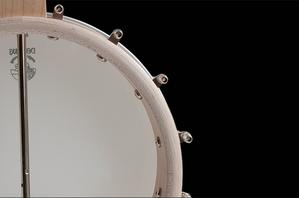While I like to tease customers that it is the “magic banjo fairy dust” that we sprinkle on each of our banjos before they ship that makes them sound so good, the truth is we continually focus on improving each and every component of our banjos to improve their sound and ease of performance.
We started the Goodtime banjo in 1996 and continue to build and improve these banjos every day. This is the perfect time to review for all of you the advances in the Goodtime banjo that make them the world’s most popular American made banjo.
· HARD ROCK MAPLE: From the onset and through to today, the Goodtime banjo necks have been made of hard rock American maple. This hard tonal wood is what gives the banjo a naturally bright sound with good sustain and power of projection.
· GEARED TUNERS: Geared guitar tuners have always been used on the Goodtime banjo. In the early years the white plastic button tuners had exposed gears which allowed the owner to know, without a doubt, that they had geared tuners that would hold better than the friction style tuners used on overseas banjos. Today’s improvements include a housed geared nickel plated tuner with a 14:1 gear ratio and an adjustment screw on the tuner button itself for tightening.
· ACCURATE SCALE: While many of us fail to focus on this, if the fret slots are not cut at the correct distances on a banjo, it will not sound musical despite our best playing efforts. This critical attention to the proper scale on our 4 string, 5 string, and 6 string banjo models is one of the reasons that banjo players around the world find them “easy to play.”
· MAPLE RIM: In the early years, Goodtime banjos had multi-ply rims of maple and birch, like the vintage Vega banjos of old. The birch has similar resonance to the maple. Through recent studies, Jens Kruger and Greg Deering found that by using violin grade maple on the rims you could enhance the tonal quality of the banjo. The violin grade maple allows each element to vibrate more freely and the sound is richer, rounder, and cleaner than ever before. Since 2008, the Goodtime banjos have 3-ply violin grade maple rims, made in the same manner as the upper line Deering banjos.

· CRIMPED BANJO HEADS: Why do today’s Deering heads sound better than others? Our new Deering heads, made especially to our particular requirements by Remo, are crimped to the aluminum ring on the banjo head (not just glued in place on one side). The American made mylar material goes into the entire channel of the aluminum edge and is crimped in place. The mylar of our top frosted heads in made in the USA and is of a higher quality. The frosted top coating is done here in the Remo California factory. All of these…better mylar, crimped attachment, and American top frosted coating, have made our new banjo heads more durable and easier to adjust to the precise tension desired.
· TENSION HOOPS: We have always made our tension hoops for our Goodtime banjos here in our Spring Valley, CA, factory. Today’s tension hoops are made of much thicker steel than the early years. This makes for a more durable tension hoop that also allows you to get a better tension on the banjo head. This ability to adjust the tension gives the player the freedom to get a brighter sounding banjo without the fear of warping the tension hoop with the hooks.
· BEST QUALITY STRINGS: Greg Deering and his R&D team are continually trying out strings to see which will give the player the best sound and the greatest durability. The Dunlop banjo strings, installed on all of our banjos since 2011, are constructed of high-grade nickel-plated steel that sound crisp and punchy and are extremely durable. The strings project loud and clear and have a smooth tactile feel. Made in their California factory, the Dunlop strings have impressed a number of our key artists with their incredible performance in both sound and durability, including The Duke of Drive, Terry Baucom.
· GOODTIME ARMREST: The vintage Vega style Goodtime banjo armrest attachment has been originally used on the Goodtime banjos was improved in 2012. Proving that he continues to listen to his customers, Greg Deering redesigned the armrest so that it will ride lower on the tension hoop and give the player a more comfortable alignment for playing, much like the flat armrest on the upperline Deering banjos. While the early armrest was also based on the vintage Vega design, it required alternate installment instructions to bring it down to tension hoop level. This design improvement allows simple attachment with the hooks without the modifications of the past.
· MADE IN THE USA: Listed last but most important of all, the Goodtime banjos continue to be made in the USA. Deering loves visitors and we truly enjoy showing everyone how we make all of our banjos, from scratch, here in our Spring Valley, CA, factory. Come on by…we’ll keep the light on for you!
"Can you play clawhammer banjo on a resonator banjo?" It's a question that comes up fairly often both on online forums and out in the public. The answer is...
When it comes to Irish tenor banjo, it is hard to define exactly what type of banjo that is. Yes, it is a four string tenor banjo. But is it a 17-fret or a...
You might have heard of or seen banjos with "scooped" fingerboards. A banjo with a scooped fingerboard is, usually starting after the 17th fret (the 18th -...
At some point or another we have undoubtedly all experienced playing instruments with satin or gloss finishes, normally favoring one over the other. And while...
3733 Kenora Dr.
Spring Valley, CA 91977
COMMENTS